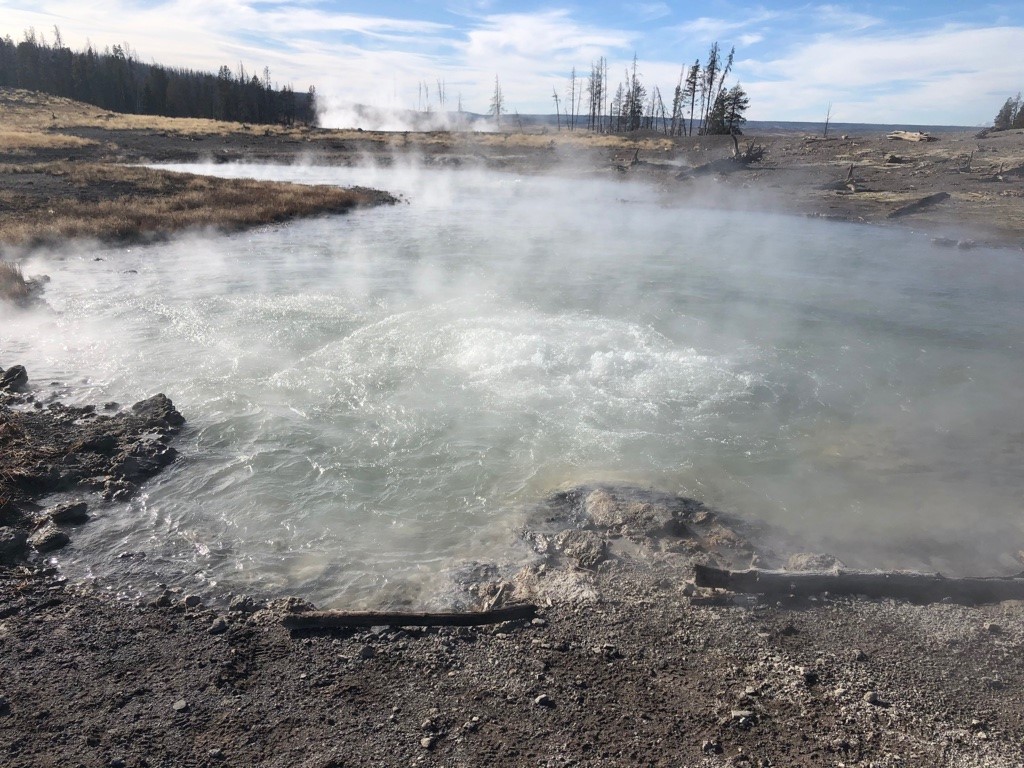Tectonic Influences on High Temperature Biosphere Habitablity
2019 - Colman
 Hydrothermal systems reflect geologic processes at a planet's surface with those from
the deep subsurface, yielding hot springs with an incredible array of chemical compositions.
Studies of microorganisms inhabiting these environments have informed our understanding
of the habitability and origin of life on Earth and the potential for life on other
planetary bodies by studies within the field of astrobiology. In particular, hydrothermal
systems, such as the hot springs of Yellowstone National Park (YNP), Wyoming, USA,
have been the focus of many astrobiological studies. The extensive chemical variation
in YNP hot springs is controlled by several subsurface geological processes including
interactions between rocks and water that occur within predominantly rhyolite (i.e.,
a silica-rich rock type) hosted hot spring settings. However, rhyolite-based volcanic
systems were unlikely to be widespread on early Earth when life is hypothesized to
have originated. Rather, early Earth was likely dominated by basalt (i.e., an iron-rich
rock type) volcanism similar to what occurs today in modern-day Iceland. Unlike our
understanding of YNP high-temperature environments, very little is known of how chemical
variation affects thermophilic communities within basalt-hosted springs (as in Iceland).
Moreover, nothing is known regarding the effects of differing chemistry on the taxonomic
and functional composition, activities, and evolution of microorganisms inhabiting
basalt versus rhyolite hydrothermal systems. These are significant areas lacking data
considering that basalt-based environments that can host life that is supported by
chemical energy are likely to be key analogs to inform our understanding of i) processes that supported early life on Earth and ii) the character of potential subsurface life on other volcanically active planetary
bodies (e.g., Europa, Enceladus and Mars).
Hydrothermal systems reflect geologic processes at a planet's surface with those from
the deep subsurface, yielding hot springs with an incredible array of chemical compositions.
Studies of microorganisms inhabiting these environments have informed our understanding
of the habitability and origin of life on Earth and the potential for life on other
planetary bodies by studies within the field of astrobiology. In particular, hydrothermal
systems, such as the hot springs of Yellowstone National Park (YNP), Wyoming, USA,
have been the focus of many astrobiological studies. The extensive chemical variation
in YNP hot springs is controlled by several subsurface geological processes including
interactions between rocks and water that occur within predominantly rhyolite (i.e.,
a silica-rich rock type) hosted hot spring settings. However, rhyolite-based volcanic
systems were unlikely to be widespread on early Earth when life is hypothesized to
have originated. Rather, early Earth was likely dominated by basalt (i.e., an iron-rich
rock type) volcanism similar to what occurs today in modern-day Iceland. Unlike our
understanding of YNP high-temperature environments, very little is known of how chemical
variation affects thermophilic communities within basalt-hosted springs (as in Iceland).
Moreover, nothing is known regarding the effects of differing chemistry on the taxonomic
and functional composition, activities, and evolution of microorganisms inhabiting
basalt versus rhyolite hydrothermal systems. These are significant areas lacking data
considering that basalt-based environments that can host life that is supported by
chemical energy are likely to be key analogs to inform our understanding of i) processes that supported early life on Earth and ii) the character of potential subsurface life on other volcanically active planetary
bodies (e.g., Europa, Enceladus and Mars).
In this project, we are conducting a number of interrelated studies aimed at determining how variation in the chemistry of hot springs in Iceland and YNP: 1) are consequences of their unique geologic settings and their associated subsurface geological processes; 2) shape microbial diversity and their activities; and 3) promote different evolutionary trajectories of microbial inhabitants. We are conducting longitudinal sampling campaigns that include a wide variety of chemically distinct springs in both Iceland and YNP. Geochemical models will be used to identify the influences of host-rock type (due to differences in geologic setting) on the geochemical variation among the springs. We will then use these data to develop new understanding of the controls on the composition of microbial communities, their functions, and their activities, among the two systems. Lastly, we will reconstruct evolutionary histories of microbial populations using recovered genomic data to test the hypothesis that Icelandic hydrothermal environments host microbial lineages and functional enzymes that are more early evolving. These results will provide critical new insight into the extent, nature, and evolution of high-temperature, globally distributed, chemically-supported biospheres, which is consistent with the goals of the NASA astrobiology program.
Contact Info
|
|
